MARGARET MELLIS

AUSTIN DESMOND FINE ART

Foreword
It is a great privilege to have worked with Margaret Mellis over the last decade. We first met in 1999 when I was curating a solo exhibition at Austin Desmond in collaboration with Newlyn Art Gallery. Margaret was 86 at the time, still full of energy and still working.
This exhibition, her third at Austin Desmond, show what is perhaps the most significant body of work Mellis has produced in her long and productive career; the driftwood. constructions. Mined from the beaches off the Suffolk coast where she has lived and worked for over 60 years, the objects and fragments thrown up by the sea which found their way into Margaret’s studio, embody the central theme of her life’s work. Started in 1980 these constructions became the focus of Mellis’s attention.
Now aged 94 Margaret is no longer working but the 20 years in which she made these constructions are her response to the world. She has carried, from a very early age, a deep understanding of colour and nowhere in her work in this more evident than in the constructions. In transforming the debris of human activity into objects that are imbued with an elemental energy, a profound expression in which humour, pathos and the poetic also play their part, ensures that Margaret Mellis has earned a place of individual distinction.
Austin Desmond would like to thank Michael Bird for his insightful and thoughtful essay on Margaret’s work. We would also like to thank Telfer Stokes for his advice and loan of archival material.
A 60 minute documentary ‘Margaret Mellis: A Life in Colour’ will be available on DVD from July 7th 2008 and can be ordered online (see p.52). The film traces Margaret’s creative life through her work and words using recordings from the National Sound Archive and with Margaret’s writings read by Susannah York.
Catriona Colledge Austin Desmond Fine Art
The Transformed Total: Margaret Mellis’s Constructions
Michael Bird
In 1978 Margaret Mellis, then in her mid-sixties, assembled some pieces of driftwood into an ad hoc sculpture. This was the beginning of what turned out to be a new phase in her art. Anyone could have picked up these fragments – wave-worn plywood boards untidily snapped like indigestible wafers, bust planks and wooden fillets that had once been painted red, blue or green for some purpose now impossible to ascertain. Rescued from the tideline dumping ground of leathery wrack and mangled rope, these scraps of unvalued jetsam were shaped by whatever had happened to happen to them. Mellis played about, arranging and rearranging, much as friends often observed her instinctively adjust the placing of ordinary objects – a bowl on a windowsill, a napkin and knife on a tabletop – until they ‘looked right’. Screwed into place, the provisional configuration became a permanent construction that could be hung on the wall and looked at. No longer spread on the floor to be accidentally destroyed or thrown back on the woodpile, it had crossed an invisible line that distinguished those ephemeral still-lifes into which Mellis conjured her domestic surroundings from the creations of her art.

1 ‘F’ 1997 driftwood construction 148 x 145 x 6cm

Adrian Stokes, Venice c.1928
It was almost fifty years earlier that she had started out as a student painter in the French-influenced mode of her tutors at Edinburgh College of Art, notably the Scottish landscapist
W.G. Gillies. There followed the semi-obligatory spell Paris in1933, studying with Gillies’s former mentor André Lhote, whose passion for Cézanne had by that time evolved into cubistic figure paintings, then further travels in France, North Africa, Italy and Spain, and another visit to Paris in summer 1937. Here, at the Exposition Internationale,1 she must have witnessed the ominously confrontational style of the Nazi German and Soviet pavilions, and may also have seen Picasso’s Guernica in the pavilion of the doomed Spanish Republic. She certainly took in an exhibition of early Cézannes in the newly constructed Palais de Tokyo, where she got into conversation with a charismatic, well-travelled English writer of improbably eclectic interests. In retrospect, the circumstances of this meeting were a mixed augury both for Mellis’s future relationship with Adrian Stokes (whom she married the following year) and for her own artistic career. Cézanne was on show as a latter-day hero of the grand tradition of French painting, but he was also venerated by the

2 Marsh Mist 1992 driftwood construction 71 x 55.3cm

Pots and Fruit c.1960 oil on hardboard 45 x 54cm
avant-garde. It took Stokes some time (and the British art public much longer) to discover that the gamine young Scottish artist who seemed, like him, engrossed by classic painterly questions of colour and form, also had it in her to play a very different kind of game.
If it was hard to be sure before then, it became clear around 1940 that Mellis was decidedly not going to spend the rest of her life producing pleasantly derivative homages to Gillies, Lhote or Cézanne. Now living in Cornwall, with the war on and, after the birth of her son Telfer in 1940, a child to care for, she nevertheless managed to create her first wholly distinctive body of work – a sporadic yet somehow confident and complete series of abstract paper collages that counts among the most vivid, unusual work to come out of St Ives during the war. Some were included in a popular 1942 exhibition in London, New Movements in Art (which in the event proved a false dawn for progressive abstract art in Britain), but professionally they got Mellis nowhere. Divorce from Stokes; a new marriage, to the painter Francis Davison (whose own career seemed to demand precedence from

‘I was simplifying my painting when Nicholson and Gabo came to St Ives in 1939. Ben Nicholson was interested and suggested that I should do a collage. At the beginning of 1940, I did one. I got completely hooked. The 11th one was the first ‘constructavist’ one, it was Construction with a Red Triangle, ( coll. Victoria and Albert Museum). Gabo liked it so much that he asked me to make another, the same. I did and it came out slightly better than the first one. When he left for America he gave it back. He said it would be useful to me.’
Margaret Mellis, October 1984
Collage with Red Triangle 1940 paper collage 29.5 x 23cm Private Collection

Margaret Mellis (right) and Francis Davison, Cannes 1948
then on); a move to southern France, well out of the London gallery orbit – all this cut across a steady career trajectory, although Mellis continued to work and exhibit. At various times between 1950 and 1980, she produced abstract paintings in the crypto-figurative postwar landscape style; spare, intense flower paintings; interestingly shaped pastel drawings on splayed envelopes; more abstract works, this time in the flat, hard-edge manner fashionable in the 1960s. A few of these pieces found their way into public collections. On the whole, though, Mellis’s loyal critics and collectors belonged to one of those secret confraternities to whom an artist’s voice speaks clear and compelling long before it gets pumped through the PA system of a public reputation. I don’t know that in 1978 even they would have guessed that her next body of work – the largest, longest sustained and, in her view, the best of her career 2 – was about to emerge from a stack of driftwood that fed the fire in the cottage in Southwold, Suffolk, to which she and Davison had moved two years earlier.

above top: Floating Tree 1958 oil on board 71 x 91cm Private Collection above: White Relief 1970 painted wood mounted on hardboard 37.7 x 37.7cm

above, top: Dying Poppies 1987 pastel and chalk on grey envelope 24 x 22.5cm
above: Purple Anenomies in Sky Blue 1988 pastel and chalk on coloured envelope 36 x 25.5cm

above top: Trees on the Shore 1958 oil on essex board 71 x 92cm Private Collection above: Half in Half c.1970/71 painted wood mounted on hardboard 58.4 x 58.4cm

Detail of studio
For some time Mellis had been in the habit of gleaning firewood during walks along the shore or in the country (she had been living in Suffolk since 1950). Once she began to think of the domestic woodpile not as free fuel but as a treasury of unique objets trouvés, however, it became impossible simply to burn it. The stack in the studio grew. In 1979 two more driftwood reliefs came out of it; in 1980 ‘a great spate of them’. 3 The series continued for more than twenty years. Judging by their titles, Mellis sometimes thought of her constructions as purely abstract formations of shape and vivid colour (Rust and Yellow, 1990), sometimes as figures or scenes that inexplicably ‘emerged’ from her intuitive process (Evening Walk, 1986), and occasionally as semi-representational icons (3 Saints, 1987–89) that she fashioned with the involuntary artifice of a sleepwalking toymaker.

3 Three Saints 1987/99 driftwood construction 48.5 x 42.3 x 4.5cm
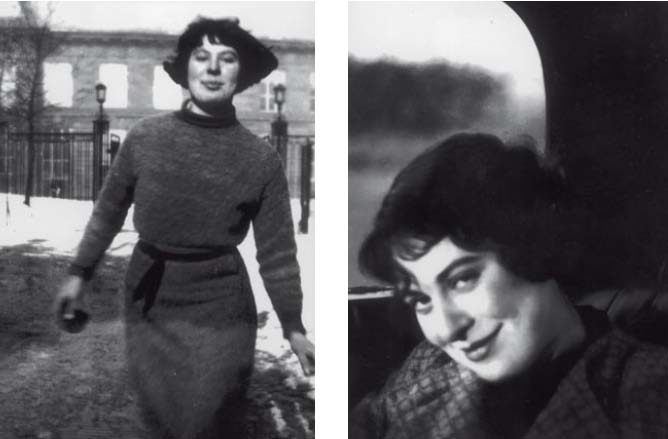
Margaret Mellis aged 16, 1930 Margaret Mellis c.1932
Surrealism is almost a century old, but we still often read found objects in a surrealistic spirit, as though they gave physical form to the workings of our own minds. The sudden collision of chance and recognition is so satisfying because, in good surrealistic style, it feels like a link snapping into place as the unconscious greets itself in the external world. Where did Margaret Mellis, daughter of a Presbyterian missionary and student of serious, respectable Scottish fauves, learn to respond in this way? It could well have been in Paris, where she must have known something of what Breton, Picasso, Ernst, Duchamp and Man Ray, among others, were up to in the 1930s. Or even through the imprint of Stokes’s forceful personality. Although, as an authority on Italian Renaissance art, he felt little enthusiasm for such anarchic modern phenomena as Dada or Surrealism, this was more than compensated for by his body-and-soul immersion in psychoanalytic theory. Wherever her instinct for passive intentionality in art, for the artist as simultaneous maker and medium, came from, she could hardly have
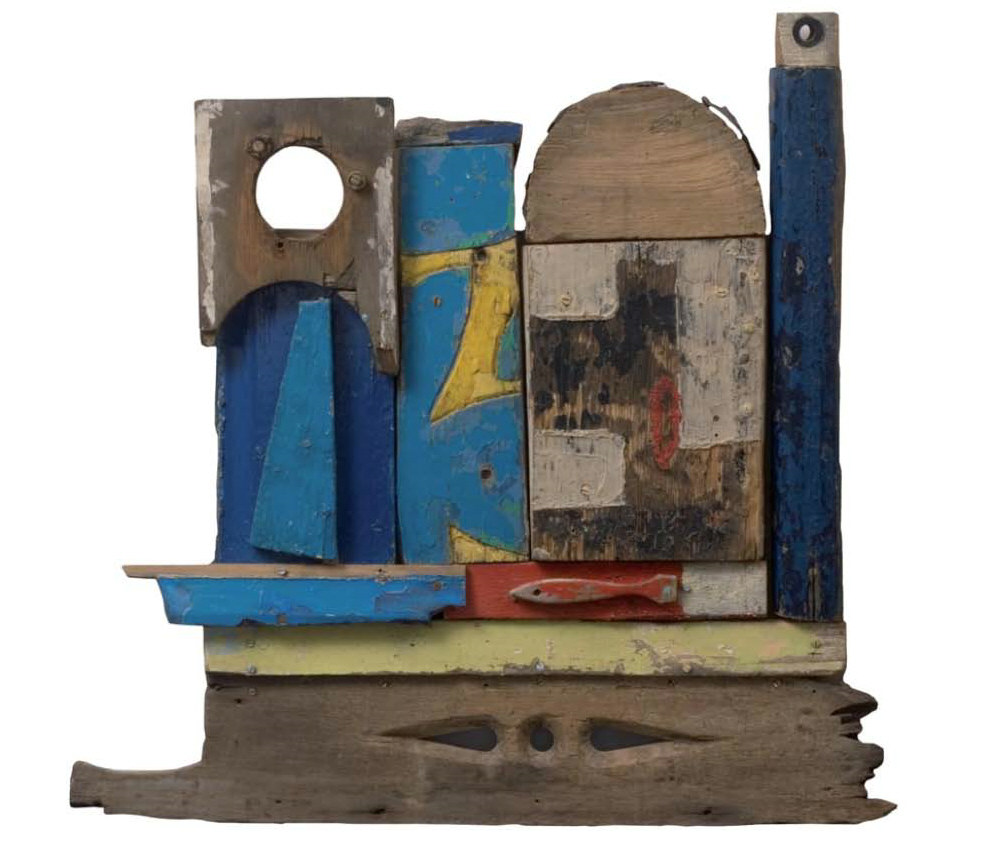
4 Marine City driftwood construction 64.8 x 64.8 x 7cm
expressed it more clearly in a description she wrote in March 1990 of the genesis of her construction Bogman (1990):
‘I found a boat skeleton in the marsh. It was half underwater, but not rotted. The dark blue paint was cracked & curling off it … I laid it down on the studio floor … almost without touching them bits of wood came out of my wood pile & lay down on the broken bones, leaving little gaps & splits of different shapes & sizes.’5
After several months, during which, while she worked on the piece for two or three hours every day, it also ‘got kicked out of shape at least twenty times’, the moment came when, ‘I knew exactly where each bit had to go. There was no choice … They couldn’t wait another minute.’ This final session lasted five and a half hours; then, as she lifted the completed construction off the floor to view it properly, ‘I got quite a surprise to see that I had a kind of man there. Later, I realised he was a Bog Man’. She did not know when she started that this strange figure would materialise, with his broken bones, his look of having been ‘impaled on a plank
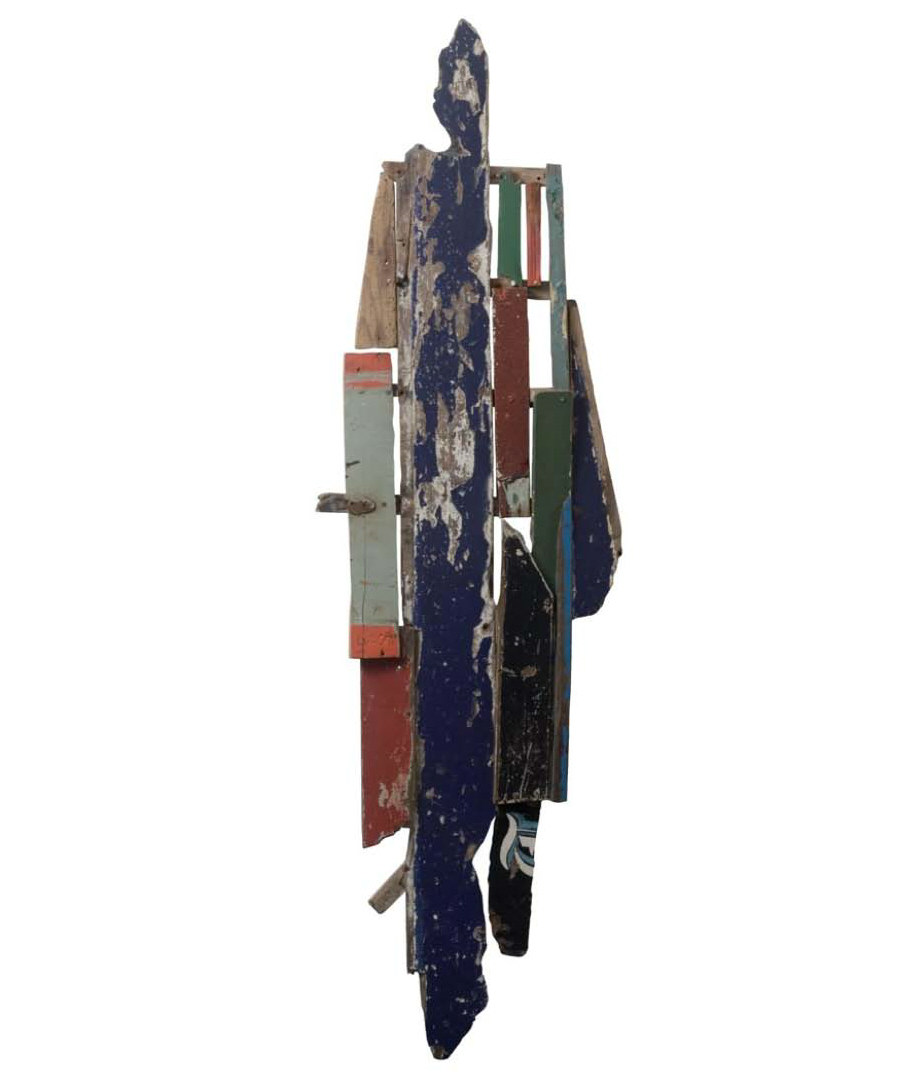
5 Bogman Jan-March 1990 driftwood construction 176.5 x 49 x 5.5cm
which had become part of his body’. Five years later, Mellis was still describing the creation of her constructions in similar terms: ‘I work as if I were making an abstract construction’, but then, ‘Something begins to happen by itself … When I start putting pieces of wood together, I am aware only of how the shapes and colour relate. I have no idea of what may happen on the way, or at the end.’ 6 In almost all Mellis’s statements about her constructions, they are said to have ‘emerged’ – unplanned, unprepared-for.
Although Mellis discovered that her driftwood constructions delivered their final ‘surprise’ through a process very close to Surrealist automatism, I don’t want to make too much of their kinship to such works as Hans Arp’s painted wooden relief The Entombment of Birds and Butterflies (1916–17) or the assemblages to which Kurt Schwitters gave the name Merz, or even, in their flayed surfaces, to the paint effects achieved by Max Ernst’s technique of decalcomania. By the early 1970s she was certainly aware of Schwitters’s work, which she saw in London around that time in Philip Granville’s collection at Lord’s Gallery. Her habits of hoarding all sorts of

6 Nine 1980 driftwood construction 39.4 x 43.2cm 7 Ten 1980 driftwood construction 76.5 x 45.7cm 8 Thirty Six 1983 driftwood construction 64 x 55 x 7cm

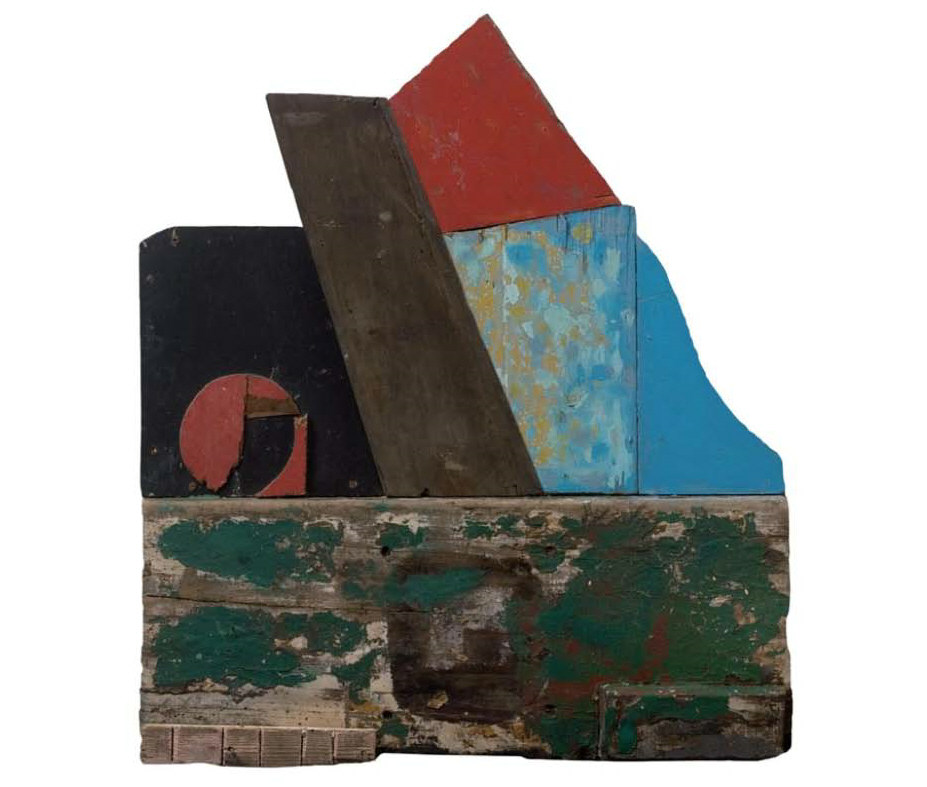
chance finds, of garnering even kitchen waste as potential material for art, were, however, already well-formed; as an inspired magpie, Schwitters struck her less as a revelation than as a man after her own heart. And in terms of colour, in any case, she liked things much stronger than most of the pioneers of collage and assemblage: Picasso, Braque, Arp, Schwitters – their excisions from the workaday world generally stuck to the café tones of scrubbed wood floors, varnished tabletops, smoky wallpaper, thumbed newsprint. Running deeper, in fact, than any such influence in the use of found objects or assemblage, was Mellis’s instinct for, and pleasure in, a certain approach to creating visual arrangements and orchestrations of colour that was current in 1930s’ Paris but which never quite took root in British art.
Early on, the nature of her personal and artistic relationships to other members of the 1930s London avant-garde revealed her individuality. No sooner had Margaret and Adrian moved in April 1939 to Little Parc Owles, a large house overlooking the sea near St Ives, than a steady stream of house guests began to turn up – sculptors, painters, writers – a roll-call

9 Nineteen 1980 driftwood construction 35 x 68.6cm

Margaret Mellis, Telfer (on right) with Miriam and Nina Gabo
Britain’s modern cultural elite, among whom Stokes was one of the best-connected men of his day. In August, shortly before war was declared, Ben Nicholson, Barbara Hepworth and their young triplets arrived (then stayed for three months), to be followed by the refugee Russian Constructivist sculptor Naum Gabo and his wife Miriam, who rented a seaside bungalow near by. Margaret, who was much younger than Adrian and most of his artist associates, may have taken a ringside seat as they continued their high-octane Hampstead conversations into the Cornish autumn, but Nicholson – habitually generous, at least where junior artists were concerned – encouraged her to get on with some art of her own. The unremittingly persuasive Gabo, meanwhile, was already cutting, bending and pasting little maquettes that embodied his ideas of ‘dynamic’ space, modest cardboard tokens of the inevitable dawning of a world-encompassing Constructivist future. Mellis’s first collage, elegant and restrained as a Nicholson still-life, coolly geometric as a Gabo construction, nevertheless reveals the sensibility that set her apart from the rest of the Little Parc Owles crowd.

10 FRAIS 1995 driftwood construction 41 x 58 x 7cm

3rd Collage July 1940 mixed media on card 26 x 33cm Private Collection
Humour, or at least a pervasive ‘charm and lightness’, is part of it. Dated July 1940, Ist Collage contains a small, upended white rectangle on which the word VALUE is printed in capital letters. Whether or not she deliberately intended it this way, the idea of value as a pasted-on snippet offers both welcome relief from, and a challenging antidote to, the earnest atmosphere in which discussion of art took place chez Stokes. From the same month, Mellis’s 3rd Collage contains a fragment of crossword puzzle; the blank squares within the square suggest, perhaps, that anyone wanting to determine the meaning of this piece will have both to seek the clues and to find the answers themselves. There’s an element of play – of teasing, even – in her choice of mind-game material, since its reason for being where it is in the collage lies not in its intellectual content but in its ‘intuitive placement’ 8 in relation to an opaque black rectangle containing a scissored white disc, a minute white triangle and a squarish yellow rectangle within a circle within a rectangle of grainy brown.

11 Whip (untitled) driftwood construction 76.2 x 61.2 x 5cm
Alongside charm and lightness, there were other ways in which Mellis’s little collages announced their independence of the milieu in which they were made – ways that Stokes might well have found hard to accept. One of his personal theories was that all art could be categorised as either carving or modelling. Even painters could be carving artists, if their work involved bringing some latent reality to the surface, a process of disclosure rather than accretion. Modelling, by contrast, meant laying on paint or piling up clay, for example, to construct objects that, however impressive in themselves, could essentially never be more than surrogates. Mellis’s collages sailed debonairly through a gap in Stokes’s thinking: their active principle involved neither carving nor modelling but was based on arrangement, moving the elements of an image around until she hit on an unforeseen ‘rightness’. This wasn’t the way most British artists worked, including Nicholson and Hepworth. While they hugely admired Mondrian’s simplification and control of the visual surface, their own respective practices remained grounded in a belief in the virtues of shaping their materials by hand, religiously
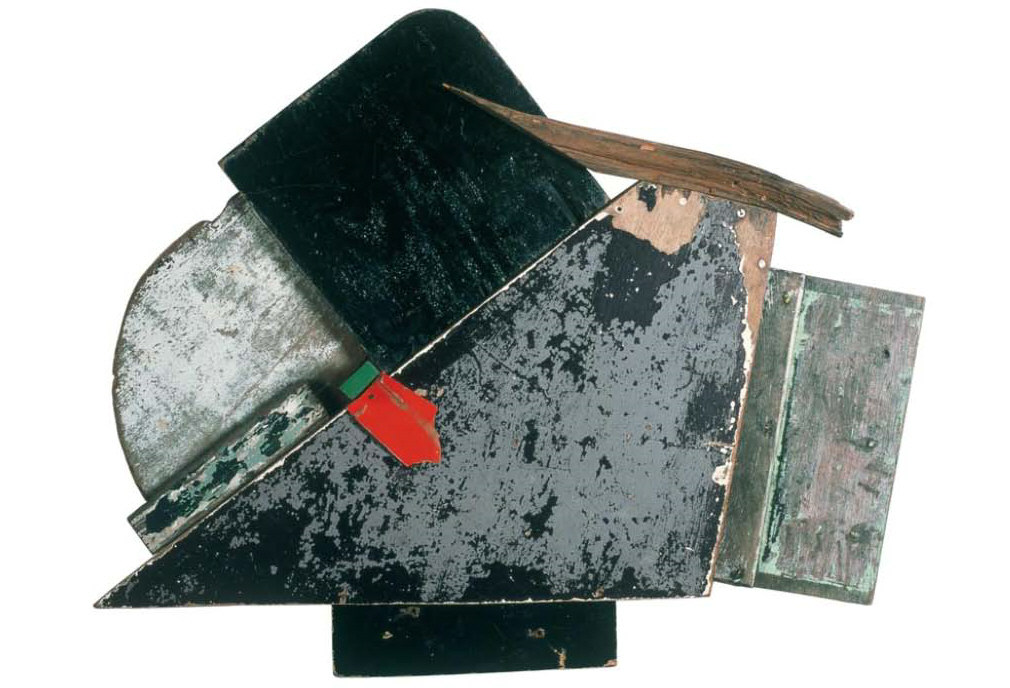
12 In the Night 1993 driftwood construction 74 x 90.5 x 7.5cm
rubbing, sanding, scraping, carving, colouring. Hepworth in particular talked about art as if it were a transcendental form of manual labour.
In Paris, on the other hand, artists of very different persuasions shared a fixation on the nature of the organised surface. In their early experiments with collage before the First World War, Picasso and Braque realised that raw material could be captured directly from the texture of daily life and redeployed it as art, not through traditional artistic techniques but as a result of the way it was arranged. For his part, Matisse moved discrete areas of painted colour around on canvas, pushed the charcoal lines in his drawings this way and that, in devoted pursuit of the ‘art of arranging’. 9 From her encounters with modern art in France, Mellis either learned or found that she already shared a similar delight in ‘arranging’. Her 1940s’ collages, so often said to be indebted to Gabo’s Constructivism, were in essence nothing like. Gabo believed that there were strict limitations to what could be achieved on a flat surface (he had a running dispute with Mondrian on this point). He

13 Scarlet Undercurrent Nov 2001 driftwood construction 198.3 x 94 x 10cm

Blue, Green, Red and Pink Collage 1941 mixed media on card 24 x 16cm Private Collection
had little interest in two-dimensional collage, and would never have done as Mellis did in using the green and white label from a bottle of ‘Dettolin Gargle’ mouthwash as a circular motif in an otherwise pure abstract design.
The Dettolin label in Blue, Green, Red and Pink Collage (1941) represents more than a serendipitously geometric, coloured shape plucked from obscurity to become abstract art. Redolent of unidealised domesticity – bathroom cabinets, tooth mugs, shopping lists – it is a found object that (we can guess) would have slipped beneath either Stokes’s or Gabo’s intellectual radar but to which Mellis’s gaze was alert. Nicholson would possibly have enjoyed this touch; but then again, the ordinary objects in which he took visual delight tended to be more conventionally either tasteful or toylike – a patterned jug, a striped fishing-float, a playing card. In the late 1930s Nicholson occasionally designed adverts, but he kept this side of his work separate

14 Sinking Boat 1989 driftwood construction 61 x 43 x 3cm

15 Cucu (reworked) 2001 driftwood construction 38 x 41 x 10cm
from his serious abstract paintings and reliefs. Ensconced as she was within Britain’s modernist inner circle, but also trying to run a home, Mellis saw no reason why household product design and pure abstract art shouldn’t share the same sheet of paper. The impulse that later led her to make constructions out of miscellaneous lumps of driftwood was the same that spurred her to introduce a mouthwash label, a square of brown parcel paper or the badge from Sobranie cigarette box into her collages.
Far more than the influence of Nicholson or Gabo, it is the spirit of Alfred Wallis that can be felt in both the early and late phases of Mellis’s work. While modernist intellectuals praised and patronised the elderly self-taught painter, Mellis seems intuitively to have empathised with Wallis’s own feelings about his art – how, when he painted on discarded packing crates, Quaker Oats boxes, any old scrap he could find, an inner world of Bible stories, memories of seaports and paranoid fantasies emerged in the guise of full-rigged ships, spectral fish or startled house-fronts whose totemic strangeness belied the epithet ‘childlike’. In a phrase that
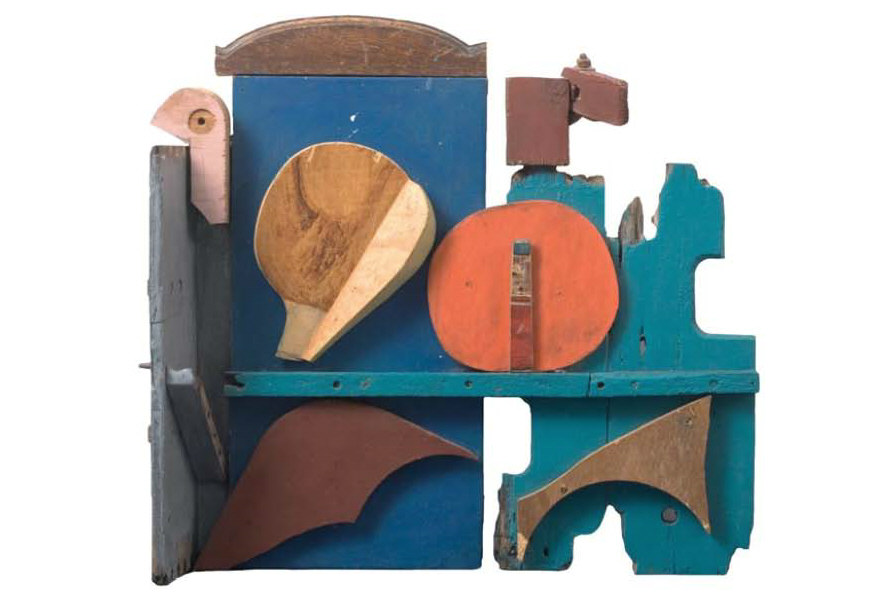
16 Toy Cupboard (Thirty) 1983 driftwood construction 54.6 x 59 x 14.6cm
could apply to Wallis himself, Mellis’s long-time friend and supporter Douglas Hall described her ‘alchemist’s ability to transmute base material into fine art’. He detected a further, moral, dimension to her constructions (in its way as foreign to modernist ideals as Wallis’s atavistic Puritanism), which he identified as a ‘passion to save and raise up the rejected’.10 Whether or not her art has a redemptive motive of this kind, it is an art in which the strictest canons of modernist-abstract taste manage to coexist with an equally forthright but utterly un-modernist negation of hierarchy. This paradox is one of the features that, confronting the fantastic jumble sale of objets trouvés, art brut, assemblages and installation pieces with which the pages of late twentieth-century art history are heaped, clears a space for Mellis’s constructions that is entirely their own.
Another feature is her distinctive response to found material, which seizes not so much to the objecthood of chance finds as on found colour. Rust and Yellow (1990), for example, could be imagined reprised in muted, salt-scrubbed tones; it would still be a substantial piece, but it

17 Rust & Yellow 1990 driftwood construction 89 x 110 x 10.8cm
would lose most of its point. The movement in the top left-hand section, from bare wood to brown paint to yellow then red draws intensity from the colours’ interaction in a way that recalls Mellis’s ardent admiration for Matisse. It aligns her with the most Francophile of the postwar St Ives generation: Heron, whom she thought perhaps too fastidious, and Hilton, whose fierce mediation between license and simplicity got results that appealed to her. In Bottom of the Deep Blue Sea (1996/97), while the sections of blue-, white- and green-painted marine plywood are again configured like a abstract painting – in their blowtorch jaggedness closer to Clyfford Still, perhaps, than Heron or Hilton – much of the colour’s vitality derives from the fact that it is not laid on deliberately but instead orchestrates the effects of chance. If, as Bonnard insisted, an artist’s real worth lies in the quality of their looking rather than their skill with a brush, by leaving paints and brushes to one side and using found colour, Mellis asks us not to admire what she has made but to see what she’s seen.

18 Bottom of the Deep Blue Sea 1996/97 driftwood construction 88.4 x 106 x 6cm
The torn-looking patches in Bottom of the Deep Blue Sea or ‘F’ (1997) or Through the Window (1990), where the wood grain beneath the paint is exposed, echo the look of ripped posters on a wall, reminding us that these surfaces consist not only of forms and colours but also of physical depth and texture. We sense, too, the action of time. The work of art has its history, but its constituent parts have histories of their own – they have already been something else (or several things – a tree, a boat, a wreck). Put together by Mellis, usually with no, or minimal, further intervention, they have not entirely shed their former lives. Here some part that had once been nailed or glued to a board has dropped off, leaving its grainy shadow; here are the tiny stigmata left by screws, nails, drill holes. If I had to explain why I find it harder to take my eyes from these scarred, peeling remnants than from intact, highly finished surfaces, I would hazard that it has to do with a kind of

19 Through the Window 1990 driftwood construction 57 x 44 x 3cm

illogical narrative expectancy – if bits of driftwood, as Mellis seems to have felt, could tell her where they belonged in a construction, surely they can (if we stare for long enough) reveal their meaning. Or is it that Mellis’s layering of surfaces and signs feels almost photographically compelling, as when a camera picks up texture in such detail that it ghosts the effect of touch? After the finding, searching and emerging had all taken place, she referred to her finished constructions as a ‘transformed total’. I would change the tense here to a present participle, since, even as you look at these works, the transforming seems still to be underway. It is as if, though all the pieces have fallen into place, the hands of the clock have not stopped.
January 2008
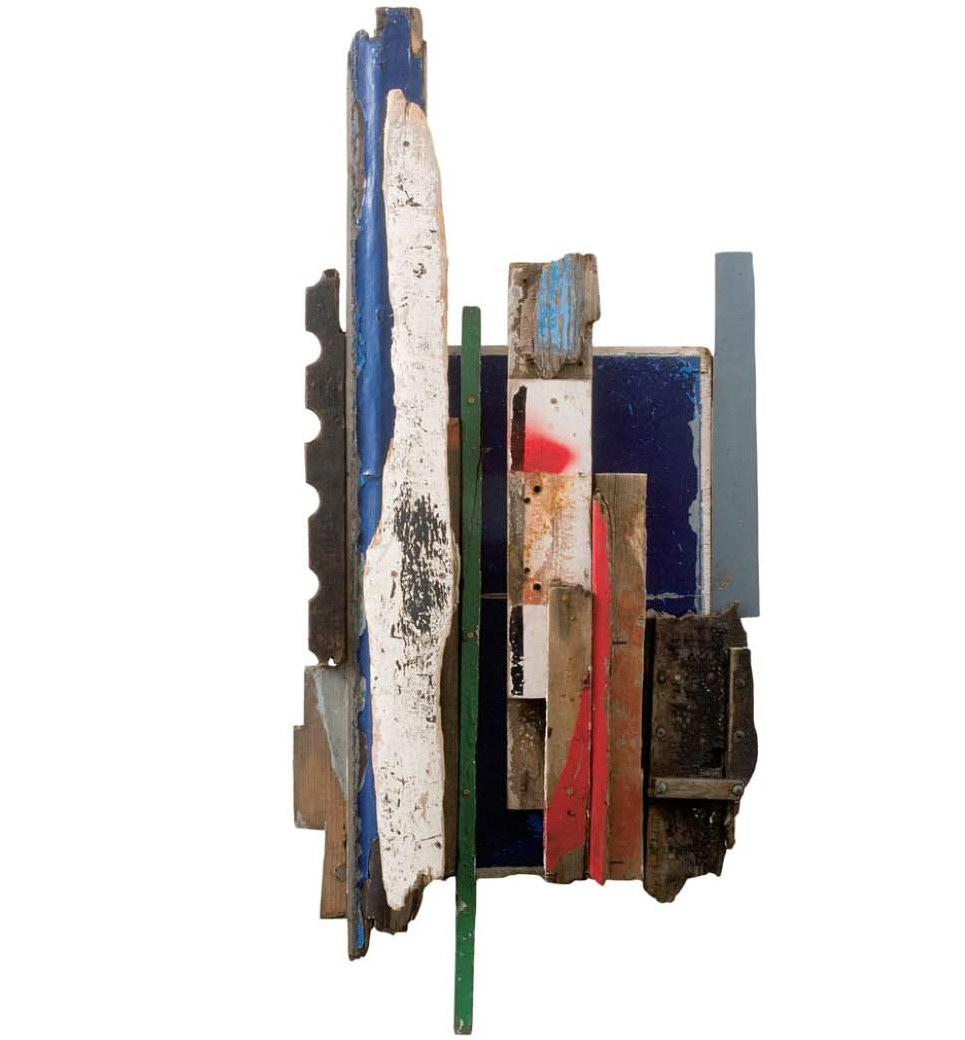
21 Rising Deep 2001 driftwood construction 116 x 55 x 10cm

Margaret with her son Telfer and grandson Laurie, Walberswick Ferry c.1987
NOTES
| 1 | The full title was Exposition Internationale des Arts et Techniques Appliqués |
| à la Vie Moderne. | |
| 2 | As reported by Douglas Hall in a talk given at the Aldeburgh Festival in |
| June 1991 (‘Margaret Mellis: Abstraction, Creation and Intuition’, | |
| unpublished typescript, pp.10–11). | |
| 3 | Margaret Mellis, ‘Driftwood Reliefs’, unpublished typescript, dated 13 |
| January 1990. | |
| 4 | Douglas Hall has described the humanoid paddle shape that appears in |
| some of these constructions as ‘an apt symbol for the soul’, a ‘perfect little | |
| icon of contemplation and hope’ (1991, p.13). | |
| 5 | Margaret Mellis, ‘Bog Man’, handwritten statement dated 14 March 1990. |
| 6 | Margaret Mellis, statement dated April 1995. |
| 7 | The phrase is Mel Gooding’s (‘A Love of What Is Real: The Art of Margaret |
| Mellis’, introduction to Margaret Mellis: A Retrospective, exh. cat., City Art | |
| Centre, Edinburgh; Kapil Jariwali, London, 1997; The Pier Gallery, | |
| Stromness, 1998, n.p.). | |
| 8 | Ibid. |
| 9 | Ibid. |
| 10 | Hall, 1991, p.2. |
LIST OF WORKS FOR SALE
| 1 | ‘F’ 1997 |
| driftwood construction 148 x 145 x 6cm | |
| 2 | Marsh Mist 1992 |
| driftwood construction 71 x 55.3cm | |
| 3 | Three Saints 1987/99 |
| driftwood construction 48.5 x 42.3 x 4.5cm | |
| 4 | Marine City |
| driftwood construction 64.8 x 64.8 x 7cm | |
| 5 | Bogman Jan-March 1990 |
| driftwood construction 176.5 x 49 x 5.5cm | |
| 6 | Nine 1980 |
| driftwood construction 39.4 x 43.2cm | |
| 7 | Ten 1980 |
| driftwood construction 76.5 x 45.7cm | |
| 8 | Thirty Six 1983 |
| driftwood construction 64 x 55 x 7cm | |
| 9 | Nineteen 1980 |
| driftwood construction 35 x 68.6cm | |
| 10 | FRAIS 1995 |
| driftwood construction 41 x 58 x 7cm |
| 11 | Whip (untitled) |
| driftwood construction 76.2 x 61.2 x 5cm | |
| 12 | In the Night 1993 |
| driftwood construction 74 x 90.5 x 7.5cm | |
| 13 | Scarlet Undercurrent Nov 2001 |
| driftwood construction 198.3 x 94 x 10cm | |
| 14 | Sinking Boat 1989 |
| driftwood construction 61 x 43 x 3cm | |
| 15 | Cucu (reworked) 2001 |
| driftwood construction 38 x 41 x 10cm | |
| 16 | Toy Cupboard (Thirty) 1983 |
| driftwood construction 54.6 x 59 x 14.6cm | |
| 17 | Rust & Yellow 1990 |
| driftwood construction 89 x 110 x 10.8cm | |
| 18 | Bottom of the Deep Blue Sea 1996/97 |
| driftwood construction 88.4 x 106 x 6cm | |
| 19 | Through the Window 1990 |
| driftwood construction 57 x 44 x 3cm | |
| 20 | Two Heads 1998 |
| driftwood construction 33 x 32 x 5cm | |
| 21 | Rising Deep 2001 |
| driftwood construction 116 x 55 x 10cm |

On Southwold beach with her grandson Laurie, 1992
MARGARET MELLIS
| 1914 | Born Wu-Kung-Fu, China, of Scottish parents |
| 1915 | Came to Scotland when aged one |
| 1929-33 | Edinburgh College of Art |
| 1932-33 | Andrew Grant Post Graduate Award (one year) |
| 1933 | Awarded One Year Travelling Scholarship, studied in Paris |
| (with André Lhote) | |
| 1933-35 | Travelled in Spain and Italy |
| 1935-37 | Fellowship at Edinburgh College of Art |
| 1938 | Euston Road School, London |
| 1938 | Married Adrian Stokes |
| 1939 | Mellis and Stokes moved to Little Parc Owles, Carbis |
| Bay, near St Ives | |
| 1940-45 | Constructivist period; worked in collage and relief carving |
| 1945 | Returned to painting |
| 1946 | Left Carbis Bay |
| 1948 | Married Francis Davison |
| 1948-50 | Moved to Cap d’Antibes, in the South of France |
| 1950 | Moved to Syleham, Suffolk |
| 1963 | Started to make colour structures |
| 1970 | Making colour reliefs |
| 1976 | Moved to Southwold in Suffolk |
| 1980 | Started to make driftwood constructions |
| 1984 | Francis Davison died |
| Lives in Southwold |
SOLO EXHIBITIONS
| 1958 | The AIA Gallery, London |
| 1959 | The Scottish Gallery, Edinburgh |
| 1967 | University of East Anglia |
| 1968 | The Bear Lane Gallery, Oxford |
| 1969 | Grabowski Gallery, London |
| 1970 | Richard Demarco Gallery, Edinburgh |
| Stirling University | |
| Exeter University | |
| 1972 | Basil Jacobs Gallery, London |
| 1976 | Compass Gallery, Glasgow |
| 1982 | The Pier Gallery, Stromness, Orkney |
| The New ’57 Gallery, Edinburgh | |
| 1987 | Redfern Gallery, London |
| 1990 | Redfern Gallery, London |
| 1991 | Peter Piers Gallery, Aldeburgh Festival |
| 1994 | Recent Constructions, Redfern Gallery, London |
| 1997 | Margaret Mellis: A Retrospective (touring) |
| City Arts Centre, Edinburgh | |
| Kapil Jariwala Gallery, London | |
| The Pier Gallery, Stromness, Orkney | |
| 2001 | Newlyn Art Gallery, Penzance |
| Austin/Desmond Fine Art, London | |
| 2004 | Paintings from the 40s, Phoenix 369, Edinburgh |
| 2005 | Strand Gallery, Aldeburgh |
| Paintings and Reliefs 1968-1978, Austin/Desmond Fine Art, | |
| London | |
| 2008 | Margaret Mellis, Constructions, Austin/Desmond Fine Art, London |
| A Life in Colour, Sainsbury Centre for Visual Arts, Norwich |
SELECTED GROUP EXHIBITIONS
1942 New Movements in Art, Contemporary Work in England (Constructivist Section), London Museum, Lancaster House, London
1958 British Section of the International Guggenheim Award, Whitechapel Art Gallery, London (touring to Brighton and Manchester)
1959-62 Waddington Galleries, London 1963-66 Hamilton Gallery, London 1963 John Moores Liverpool Exhibition 4 1965 John Moores Liverpool Exhibition 5 1966 Open Paintings Exhibition, Ulster Museum, Belfast 1967 Edinburgh Open 100 1971 Art Spectrum 1973 The Five Show, Kettles Yard, Cambridge 1977 First Prize 1st Open East Anglian Exhibition, Norwich
Painting in Cornwall 1945-55, New Art Centre, London 1978 Objects (Recent Acquisitions), Victoria & Albert Museum, London
Pier Gallery Collection Exhibition, Tate Gallery, London 1982 The Women’s Art Show 1550-1970, Castle Museum, Nottingham 1985 St Ives 1939-64, Tate Gallery, London
International Art Fair, Olympia (Scottish Gallery, London) International Art Fair, Olympia (Redfern Gallery, London) 1989 Scottish Art Since 1900, Scottish National Gallery of Modern Art, Edinburgh and The Barbican, London 1990 Scottish Art 1900-1990, The Scottish Gallery, London Glasgow’s Great British Art Exhibition, McLellan Galleries, Glasgow
| The Compass Contribution: 21 Years of Contemporary Art | |
|---|---|
| 1969-1990, Tramway, Glasgow | |
| 1992 | Margaret Mellis and Francis Davison, Gainsborough’s |
| House, Sudbury, Suffolk | |
| Artists from Cornwall, Royal West of England Academy, | |
| Bristol | |
| 1993 | Inaugural Exhibition, Tate Gallery, St Ives |
| 1996 | Margaret Mellis and Francis Davison, Bede Gallery, Jarrow |
| 2004 | The French Connection, Phoenix 369, Edinburgh |
| 2007 | Art For Life, Chelsea and Westminster Hospital, London |
PUBLIC COLLECTIONS
Arts Council of England Contemporary Arts Society Cornwall County Council Eastern Arts Association Ferens Art Gallery, Hull Graves Collection, Sheffield Government Art Collection John Player Collection, Nottingham Leicestershire, Nottingham (Trentbridge) and Derby Education Committees The Minories, Colchester Museum Sztuki w Lodzi, Poland Nuffield Foundation Pier Gallery Collection, Stromness, Orkney Sainsbury Centre, Norwich Scottish Arts Council Scottish National Gallery of Modern Art, Edinburgh Stirlingshire Educational Trust Tate Collection, London Victoria & Albert Museum, London

Austin/Desmond Fine Art
Pied Bull Yard 68-69 Great Russell Street UK - London WC1B 3BN
- (t)
- +44 (0)20 7242 4443
- (f)
- +44 (0)20 7404 4480
- (e)
- gallery@austindesmond.com
- (w)
- www.austindesmond.comMon – Fri 10.30am – 5.30pm Sat 11.00 – 2.30pm (during exhibitions only)
IBSN 978-1-872926-26-1
Exhibition curated by Catriona Colledge / David Archer Catalogue photography by Colin Mills Introductory essay by Michael Bird Catalogue design by Peter Gladwin Printed by Creative Group London Jan 2008